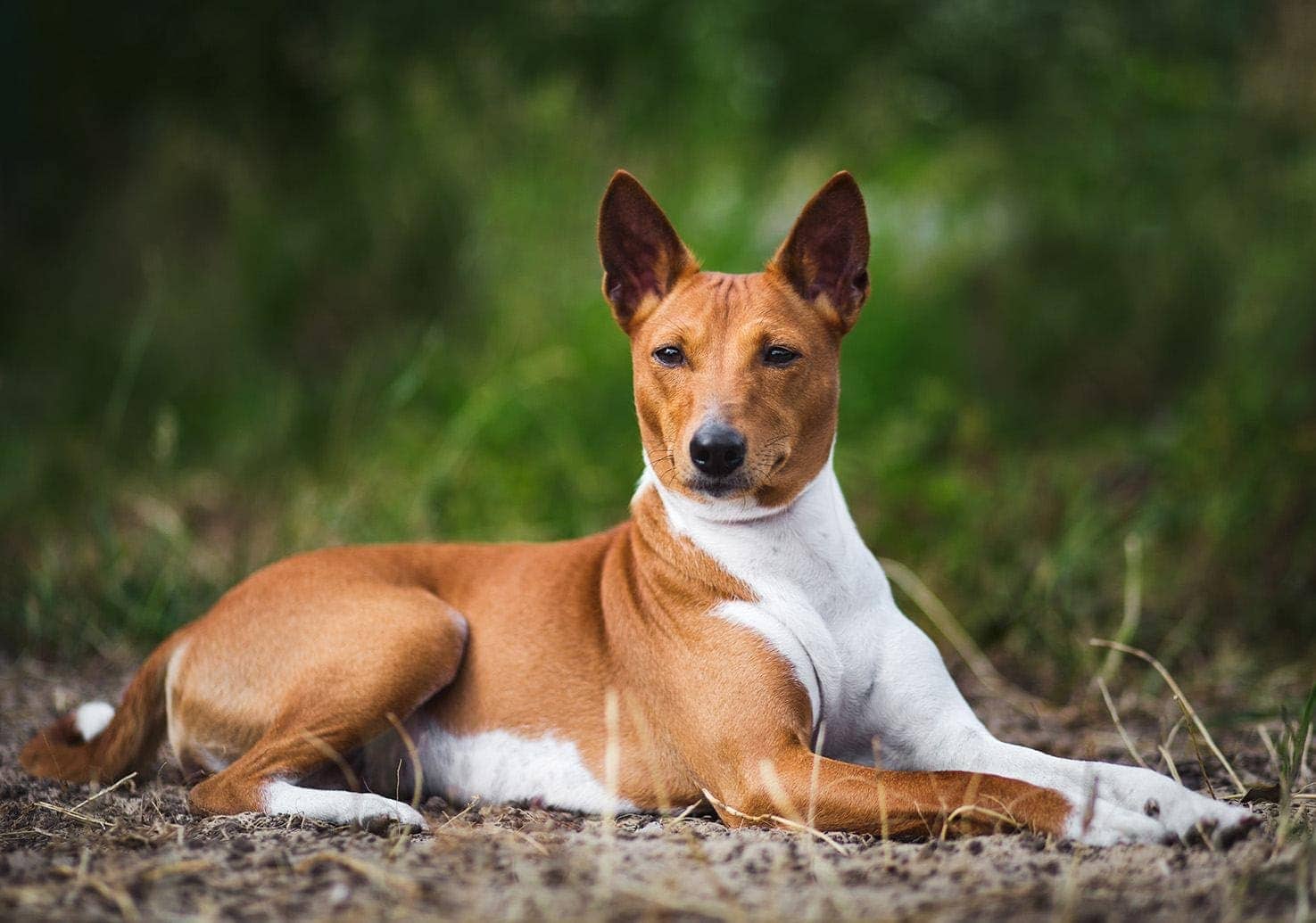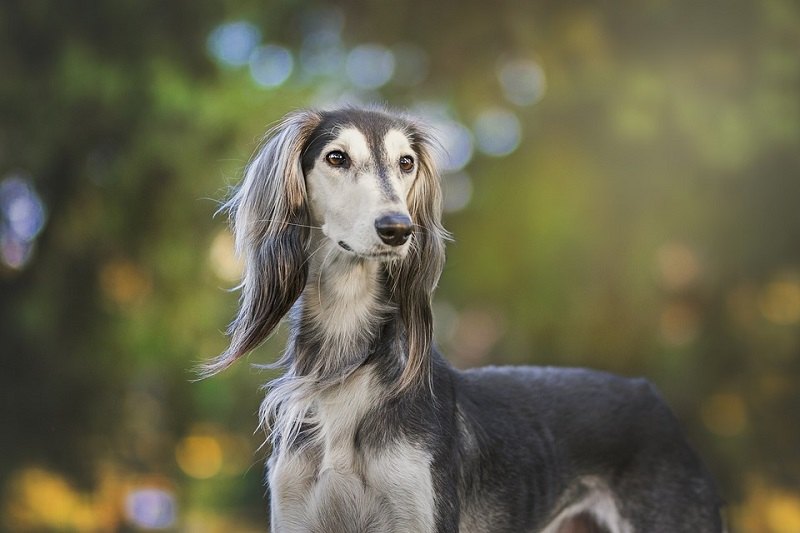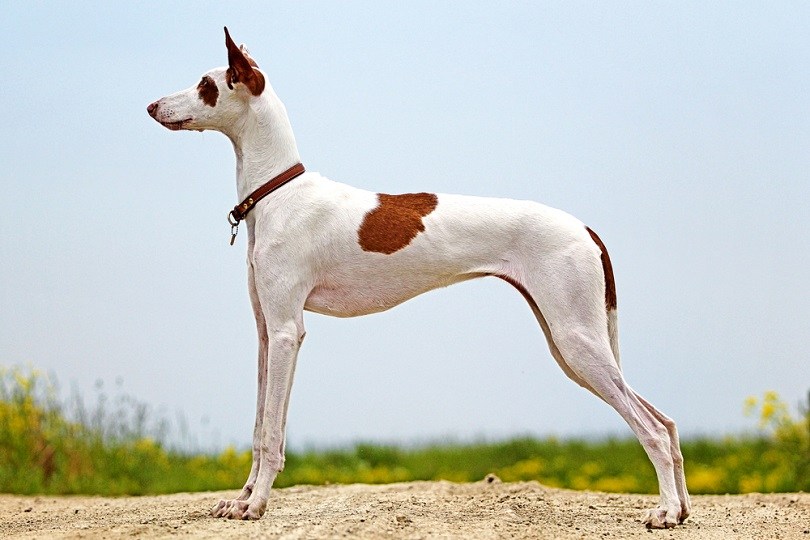Baladi Street Dog
Also known as the Thebes Land Dog, the Baladi Street Dog is the most common dog in Egypt. These are strays that populate city streets across the country, and as such, they’re not a proper breed, even though they’re often referred to as one.
They have long, lean bodies and pricked ears, causing them to resemble Dingoes or other semi-feral breeds. They can make wonderful pets, but unfortunately, they’re prone to being abused by members of the public who don’t appreciate encountering packs of strays every time they venture out into the street.

Known for their curled tails that pile up on their backs, Basenjis are often seen depicted on the tombstones of ancient Pharaohs. They’re also quite common in Africa, where they’re sometimes referred to as “the Congo Dog.”
These dogs are fantastic hunters, and they were often entrusted to use their own instincts while on a hunt. As a result, they’re extremely independent, even while being friendly and outgoing. They’re calm and somewhat aloof, making them a poor choice for anyone who wants their pup permanently attached to their lap.

The Saluki may be the oldest dog breed on the planet. Resembling a long-haired Greyhound, these Egyptian dogs have been depicted on all types of ancient artifacts. Their regal demeanor and ability to run down nearly every possible prey made them extremely valuable to Egyptian royalty, and military leaders from other countries often traded for them as well.
They’re incredibly fast and need a great deal of exercise, and they shouldn’t be kept in a house with smaller animals, as they’re quite incapable of turning off their prey drive. Once they’re tuckered out, though, they’re likely to spend the rest of their day sleeping rather than bothering you.

There’s a certain amount of controversy as to where the Ibizan Hound originated, as some believe that they came from the Balearic Islands off the coast of Spain. Others, however, point to the fact that mentions of the breed have been found on ancient Egyptian artifacts as proof of their true heritage.
Regardless of their place of origin, the Ibizan Hound is an extremely athletic dog that can easily handle virtually any terrain. They’re energetic and require a ton of exercise, making them a poor choice of pet for apartment dwellers or sedentary owners. For everyone else, though, these dogs are affectionate companions that can truly make your house into a home.
Breed Characteristics:
Contrary to popular belief, small size doesnt necessarily an apartment dog make. Plenty of small dogs are too high-energy and yappy for life in a high-rise. Being quiet, low energy, fairly calm indoors, and polite with the other residents are all good qualities in an apartment dog. And you can find an awesome crate for your dog here to give them a little more personal space in your apartment.
Some dogs are simply easier than others; they take to training better and are fairly easygoing. Theyre also resilient enough to bounce back from your mistakes or inconsistencies.
Dogs who are highly sensitive, independent thinking, or assertive may be harder for a first-time dog parent to manage. Youll get your best match if you take your dog-owning experience into account as you choose your new pooch.
If youre new to dog parenting, take a look at 101 Dog Tricks and read up on how to train your dog!
Some dogs will let a stern reprimand roll off their backs, while others take even a dirty look to heart. Low-sensitivity dogs, also called “easygoing,” “tolerant,” “resilient,” and even “thick-skinned,” can better handle a noisy, chaotic household, a louder or more assertive owner, and an inconsistent or variable routine. Do you have young kids, throw lots of dinner parties, play in a garage band, or lead a hectic life? Go with a low-sensitivity dog.
Some breeds bond very closely with their family and are more prone to worry or even panic when left alone by their owner. An anxious dog can be very destructive–barking, whining, chewing, and otherwise causing mayhem. These breeds do best when a family member is home during the day or if you can take the dog to work.
Breeds with very short coats and little or no undercoat or body fat, such as Greyhounds, are vulnerable to the cold. Dogs with a low cold tolerance need to live inside in cool climates and should have a jacket or sweater for chilly walks. You can find a great jacket for your dog here!
Dogs with thick, double coats are more vulnerable to overheating. So are breeds with short noses, like Bulldogs or Pugs, since they cant pant as well to cool themselves off. If you want a heat-sensitive breed, your dog will need to stay indoors with you on warm or humid days, and youll need to be extra cautious about exercising your dog in the heat.
Some breeds are independent and aloof, even if theyve been raised by the same person since puppyhood; others bond closely to one person and are indifferent to everyone else; and some shower the whole family with affection. Breed isnt the only factor that goes into affection levels; dogs who were raised inside a home with people around feel more comfortable with humans and bond more easily.
Being gentle with children, sturdy enough to handle the heavy-handed pets and hugs they can dish out, and having a blasé attitude toward running, screaming children are all traits that make a kid-friendly dog. You may be surprised by whos on that list: Fierce-looking Boxers are considered good with children, as are American Staffordshire Terriers (which are considered Pit Bulls). Small, delicate, and potentially snappy dogs such as Chihuahuas arent always so family-friendly.
**All dogs are individuals. Our ratings are generalizations, and theyre not a guarantee of how any breed or individual dog will behave. Dogs from any breed can be good with children based on their past experiences, training on how to get along with kids, and personality. No matter what the breed or breed type, all dogs have strong jaws, sharp pointy teeth, and may bite in stressful circumstances. Young children and dogs of any breed should always be supervised by an adult and never left alone together, period.
Friendliness toward dogs and friendliness toward humans are two completely different things. Some dogs may attack or try to dominate other dogs, even if theyre love-bugs with people; others would rather play than fight; and some will turn tail and run. Breed isnt the only factor. Dogs who lived with their littermates and mother until at least six to eight weeks of age and who spent lots of time playing with other dogs during puppyhood, are more likely to have good canine social skills.
Stranger-friendly dogs will greet guests with wagging tails and nuzzles; others are shy, indifferent, or even aggressive. However, no matter what the breed, a dog who was socialized and exposed to lots of different types, ages, sizes, and shapes of people as a puppy will respond better to strangers as an adult. Remember that even friendly dogs should stay on a good, strong leash like this one in public!
If youre going to share your home with a dog, youll need to deal with some level of dog hair on your clothes and in your house. However, shedding does vary greatly among the breeds. Some dogs shed year-round, some “blow” seasonally, some do both, and some shed hardly at all. If youre a neatnik, youll need to either pick a low-shedding breed or relax your standards. To help keep your home a little cleaner, you can find a great de-shedding tool here!
Drool-prone dogs may drape ropes of slobber on your arm and leave big, wet spots on your clothes when they come over to say hello. If youve got a laid-back attitude toward slobber, fine; but if youre a neatnik, you may want to choose a dog who rates low in the drool department.
Some breeds are brush-and-go dogs; others require regular bathing, clipping, and other grooming just to stay clean and healthy. Consider whether you have the time and patience for a dog who needs a lot of grooming, or the money to pay someone else to do it.
Due to poor breeding practices, some breeds are prone to certain genetic health problems, such as hip dysplasia. This doesnt mean that every dog of that breed will develop those diseases; it just means that theyre at an increased risk.
If youre adopting a puppy, its a good idea to find out which genetic illnesses are common to the breed youre interested in. You may also want to ask if your shelter or rescue has information about the physical health of your potential pups parents and other relatives.
Some breeds have hearty appetites and tend to put on weight easily. As in humans, being overweight can cause health problems in dogs. If you pick a breed thats prone to packing on pounds, youll need to limit treats, make sure they get enough exercise, and measure out their daily food servings into regular meals rather than leaving food out all the time.
Ask your vet about your dogs diet and what they recommend for feeding your pooch to keep them at a healthy weight. Weight gain can lead to other health issues or worsen problems like arthritis.
Dogs come in all sizes, from the worlds smallest pooch, the Chihuahua, to the towering Great Dane, how much space a dog takes up is a key factor in deciding if theyre compatible with you and your living space. Large dog breeds might seem overpowering and intimidating, but some of them are incredibly sweet! Take a look and find the right sized dog for you!
Easy-to-train dogs are more adept at forming an association between a prompt (such as the word “sit”), an action (sitting), and a consequence (getting a treat) very quickly. Other dogs need more time, patience, and repetition during training.
Many breeds are intelligent but approach training with a “Whats in it for me?” attitude, in which case youll need to use rewards and games to teach them to want to comply with your requests.
Dogs who were bred for jobs that require decision making, intelligence, and concentration, such as herding livestock, need to exercise their brains, just as dogs who were bred to run all day need to exercise their bodies. If they dont get the mental stimulation they need, theyll make their own work–usually with projects you wont like, such as digging and chewing. Obedience training and interactive dog toys are good ways to give a dog a brain workout, as are dog sports and careers, such as agility and search and rescue.
Common in most breeds during puppyhood and in Retriever breeds at all ages, mouthiness means a tendency to nip, chew, and play-bite (a soft, fairly painless bite that doesnt puncture the skin). Mouthy dogs are more likely to use their mouths to hold or “herd” their human family members, and they need training to learn that its fine to gnaw on chew toys, but not on people. Mouthy breeds tend to really enjoy a game of fetch, as well as a good chew on a toy thats been stuffed with kibble and treats.

(Picture Credit: Haydn West – PA s/PA s via Getty s)
Dogs who were bred to hunt, such as Terriers, have an inborn desire to chase–and sometimes kill–other animals. Anything whizzing by, such as cats, squirrels, and perhaps even cars, can trigger that instinct. Dogs who like to chase need to be leashed or kept in a fenced area when outdoors, and youll need a high, secure fence in your yard. These breeds generally arent a good fit for homes with smaller pets that can look like prey, such as cats, hamsters, or small dogs. Breeds that were originally used for bird hunting, on the other hand, generally wont chase, but youll probably have a hard time getting their attention when there are birds flying by.
Some breeds sound off more often than others. When choosing a breed, think about how often the dog vocalizes with barks or howls. If youre considering a hound, would you find their trademark howls musical or maddening? If youre considering a watchdog, will a city full of suspicious “strangers” put your pup on permanent alert? Will the local wildlife literally drive your dog wild? Do you live in housing with noise restrictions? Do you have neighbors nearby? Then you may wish to choose a quieter dog.
Some breeds are more free-spirited than others. Nordic dogs such as Siberian Huskies were bred to range long distances, and given the chance, theyll take off after anything that catches their interest. And many hounds simply must follow their noses–or that bunny that just ran across the path–even if it means leaving you behind.
High-energy dogs are always ready and waiting for action. Originally bred to perform a canine job of some sort, such as retrieving game for hunters or herding livestock, they have the stamina to put in a full workday. They need a significant amount of exercise and mental stimulation, and theyre more likely to spend time jumping, playing, and investigating any new sights and smells.
Low-energy dogs are the canine equivalent of a couch potato, content to doze the day away. When picking a breed, consider your own activity level and lifestyle, and think about whether youll find a frisky, energetic dog invigorating or annoying.
A vigorous dog may or may not have high energy, but everything they do, they do with vigor: they strain on the leash (until you train them not to), try to plow through obstacles, and even eats and drinks with great big gulps. These dynamos need lots of training to learn good manners, and may not be the best fit for a home with young kids or someone whos elderly or frail. A low-vigor dog, on the other hand, has a more subdued approach to life.
Some breeds do fine with a slow evening stroll around the block. Others need daily, vigorous exercise, especially those that were originally bred for physically demanding jobs, like herding or hunting.
Without enough exercise, these breeds may put on weight and vent their pent-up energy in ways you dont like, such as barking, chewing, and digging. Breeds that need a lot of exercise are good for outdoorsy, active people, or those interested in training their dog to compete in a high-energy dog sport, such as agility.
Some dogs are perpetual puppies — always begging for a game — while others are more serious and sedate. Although a playful pup sounds endearing, consider how many games of fetch or tag you want to play each day, and whether you have kids or other dogs who can stand in as playmates for the dog.
The Saluki: First bred in Mesopotamia by the Sumerians, the Saluki was one of the most popular breeds in the region and, later, in Egypt. Amulets and art work in Mesopotamia regularly depict this breed and it has been found in graves with and without human remains accompanying the bones. The Saluki (or Sloughi breed) was definitely present in Egypt, in spite of claims to the contrary, just not as early as in Mesopotamia. Salukis are clearly represented in tomb paintings and stelae as hunting dogs and companions.
The Basenji: This breed is among the best attested to in ancient Egypt. It no doubt came from Nubia where it seems to have been quite common. The name is usually translated as “dog of the villagers” because it was so commonly associated with communities of people. The Basenji was used in hunting small game and as a companion, family pet, and guard dog. Basenjis could be among the dogs on the funerary stele of Intef II (2112-2063 BCE) of the 11th Dynasty and possibly his favorite dog, Beha, for whom he had an individual stele carved.
Dogs are represented in Egyptian art work from the Pre-Dynastic Period forwards either as companions, at the hunt, or in afterlife vignettes. They also appear on ceramics such as the siltstone palettes which were used in daily life (such as the Four Dogs Palette at the Louvre for cosmetics) or in ceremonies or commemorations (as with the Narmer Palette).
Prior to the domestication of any of these animals, however, is that of the dog. Scholars have reached this conclusion based upon physical evidence from graves as well as inscriptions and tomb paintings. The dog, either a Basenji, Greyhound, or Saluki, is frequently depicted helping to herd cattle, wearing a wide collar fastened with a bow at the back of the neck.
The Pharaoh: This breed is routinely claimed to have originated much later, in the 17th century CE on Malta, but its ancestors are thought to have been kept by the ancient Egyptians. Most likely it was an Egyptian breed brought to Malta by Phoenician traders. This claim is based upon art work, such as that on the tomb of Intef II toward the end of the First Intermediate Period (2181-2040 BCE). His funerary stele depicts dogs which resemble a breed similar to the later pharaoh hound more than other known Egyptian breeds. The Pharaoh is often depicted in hunting scenes and was considered the best breed for sacrifice to Anubis at Cynopolis.